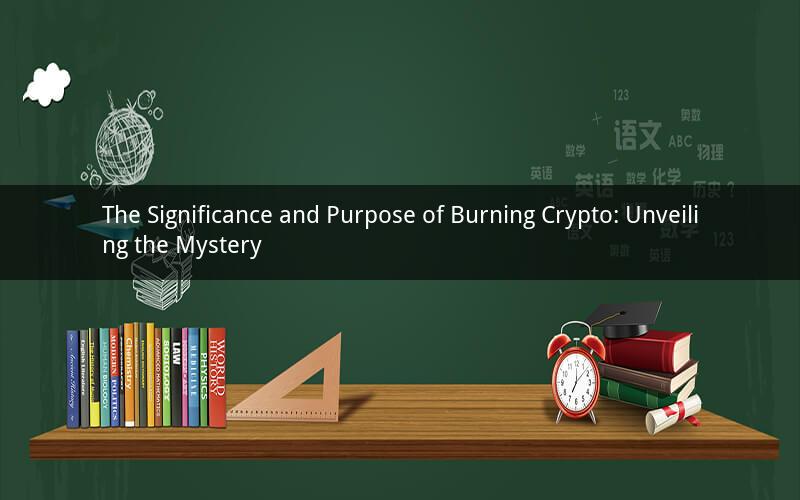
In the ever-evolving world of cryptocurrencies, the term "burning crypto" has gained significant attention. But what exactly is the purpose behind this practice? This article delves into the reasons behind burning crypto, its implications, and the potential benefits it brings to the crypto community.
1. What is Crypto Burning?
Crypto burning, also known as token burning, is a process where a certain amount of cryptocurrency is permanently removed from circulation. This practice is often implemented by blockchain projects to control the supply of their tokens, increase scarcity, and potentially boost the value of their assets.
2. Reasons for Burning Crypto
a. Controlling Supply and Increasing Scarcity
One of the primary reasons for burning crypto is to control the supply and increase scarcity. By reducing the total number of tokens in circulation, projects can create a sense of scarcity, making their tokens more valuable. This is particularly beneficial for projects with a finite supply of tokens, as it helps to maintain the long-term value of their assets.
b. Enhancing Token Value
As mentioned earlier, burning crypto can lead to an increase in token value. When a token becomes scarcer, its demand may rise, causing its price to increase. This can be a significant advantage for investors, as they may benefit from the rising value of their holdings.
c. Demonstrating Commitment to Long-Term Success
By burning tokens, projects can demonstrate their commitment to the long-term success of their blockchain. This can help to build trust among investors and the wider community, as it shows that the project is serious about achieving its goals.
d. Reducing Inflationary Pressure
In the crypto world, inflationary pressure can be a significant concern. By burning tokens, projects can reduce the inflationary pressure on their network, as there will be fewer new tokens entering the market. This can help to stabilize the value of the tokens and make the network more attractive to potential users.
3. The Process of Crypto Burning
The process of burning crypto varies depending on the blockchain platform and the specific project. Generally, the process involves the following steps:
a. Identifying the Tokens to Be Burned
The first step is to identify the tokens that will be burned. This could be a specific percentage of the total supply or a predetermined number of tokens.
b. Creating a Smart Contract
A smart contract is a self-executing contract with the terms of the agreement directly written into code. For token burning, a smart contract is used to automate the process of removing tokens from circulation.
c. Implementing the Burn
Once the smart contract is created, the tokens are burned by sending them to a "black hole" address, which is essentially a non-existent address that no one can access. This ensures that the tokens are permanently removed from circulation.
d. Notifying the Community
After the tokens have been burned, it is essential to notify the community to ensure transparency and maintain trust.
4. Potential Benefits of Crypto Burning
a. Increased Token Value
As mentioned earlier, burning crypto can lead to an increase in token value. This can be a significant advantage for investors and can help to create a more stable and valuable ecosystem.
b. Enhanced Community Trust
By burning tokens, projects can demonstrate their commitment to the long-term success of their blockchain. This can help to build trust among investors and the wider community, leading to increased adoption and usage of the network.
c. Reduced Inflationary Pressure
As mentioned earlier, burning crypto can reduce inflationary pressure on a network, making it more attractive to potential users and investors.
5. Potential Risks of Crypto Burning
a. Potential Manipulation
While burning crypto can have several benefits, there is a risk of manipulation. Projects may burn tokens to create a false sense of scarcity and boost their token value, only to sell their tokens later at a higher price.
b. Lack of Transparency
In some cases, the process of burning crypto may lack transparency, making it difficult for investors and the wider community to verify the authenticity of the burn.
6. Conclusion
The purpose of burning crypto is multifaceted, encompassing the control of supply, increase in token value, and demonstration of commitment to long-term success. While there are potential risks and challenges associated with this practice, the benefits of crypto burning can be significant for both projects and investors. As the crypto world continues to evolve, understanding the purpose and implications of burning crypto is crucial for anyone looking to navigate this dynamic landscape.
Questions and Answers:
1. Q: Can burning crypto lead to a decrease in token value?
A: No, burning crypto typically leads to an increase in token value due to the reduced supply and increased scarcity.
2. Q: Is there a specific amount of tokens that should be burned?
A: There is no specific amount of tokens that should be burned. The decision depends on the project's goals and the amount of tokens they believe will be beneficial to burn.
3. Q: Can burning crypto help in reducing inflationary pressure?
A: Yes, burning crypto can help in reducing inflationary pressure by reducing the number of new tokens entering the market.
4. Q: Is crypto burning a common practice in the crypto world?
A: Yes, crypto burning is a common practice among blockchain projects, particularly those with a finite supply of tokens.
5. Q: Can burning crypto be reversed?
A: No, once tokens are burned, they cannot be reversed. This ensures that the tokens are permanently removed from circulation.